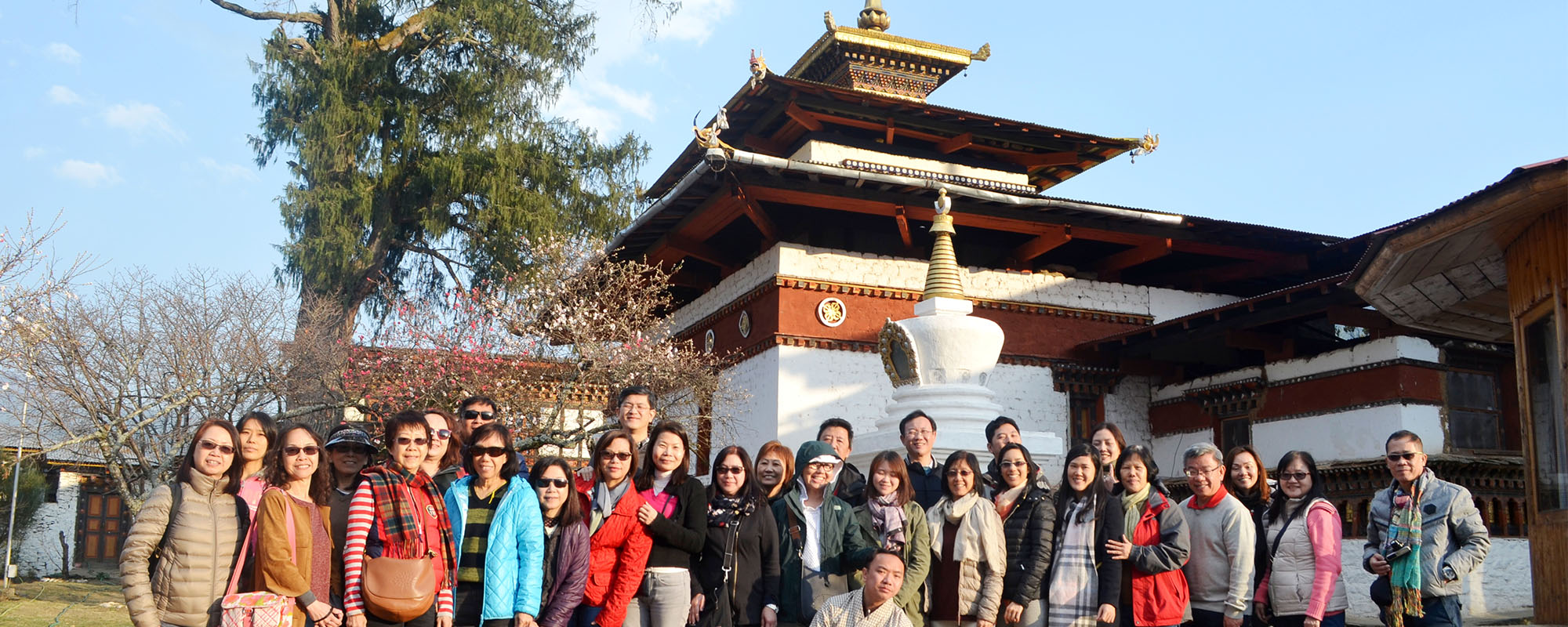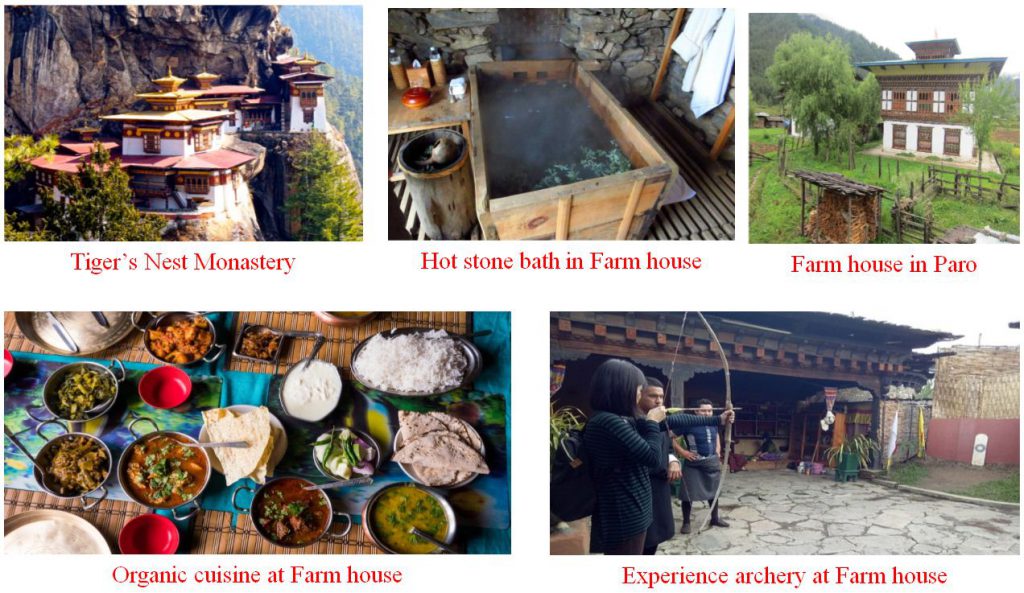
Duration: 11 Days, 10 Nights.
Locations: Thimphu, Paro, Punakha and Wangduephodrang, Trongsa and Bumthang.
Highlight: Visits to the important cultural and historic sites. Visit to some of the sacred temples in Bhutan. You will be going to some of the most beautiful valleys of Bhutan such as Bumthang, Phobjikha, Punakha valley,Central Bhutan is one of the most beautiful and sacred valleys of Bhutan. You will also wear Bhutan’s traditional costumes (gho – men, kira – women), visit to pristine valley of Ura village, blessing in sacred temples, hiking in the pristine forest of Ura, picnic lunch at some of the most beautiful locations in Bhutan, maximum sightseeing and tours.
Fly into Paro by Druk Air, Bhutan’s National Airline. The great snow-capped peaks of the inner Himalayas rise up to the heavens can be seen during clear weather. As the plane approaches Bhutan, if you look down farmhouses as dots on the hillsides can be seen.
As the aircraft enters the Paro valley, you will see Paro Dzong on the hillside overlooking the Paro Chu (river), with Ta Dzong, formerly a watchtower and now the National Museum, above it. You will be received by the representative of Yelha Bhutan Tours and Travels (Bhutan tour operator) who will be your Bhutan travel guide throughout your tour.
After meeting with the guide and driver then drive to Thimphu, the capital of Bhutan. Check into the hotel and rest for a while and then visit Buddha Dordenma (the larges Buddha Statue at Kuenselphodrang), Memorial stupa, Tashi Chhodzong and the stroll through the town in the evening.
Overnight at a hotel in Thimphu

After the breakfast, we will visit Institute of Zorig Chusum (Institute of 13 Arts and Crafts) where students undergo 6-year training course in Bhutan’s 13 traditional arts and crafts.
Changzamtog National Weaving Centre, Takin Preserve which houses the national animal- takin which is found only in Bhutan. Takin is an extremely rare member of goat family.
Then visit Changangkha temple and end with Centenary Farmer’s Market where farmers sell their farm produces ( vegetables, fruits, cereals, spices, wild vegetable collections, livestock products and free interaction with local people who come shopping to this market, especially on weekends.

After breakfast drive to Gangtey and Phobjikha valley. Phobjikha valley has been declared as the first eco-tourism destination of Bhutan by the Royal Society for Protection of Nature (RSPN).
The valley falls under the Black Mountain Natural Park. Phobjikha valley is the winter home to rare and endangered black necked cranes (grus nigricllis), which migrate, in large flocks to Bhutan from Tibet &
Sikang, Yunnan and Tonkin in eastern China.
There are lots of other wild animals in the surrounding valleys like wild boar, barking deer, Himalayan, black bear, red fox, leopard and many species of birds. Overnight Phobjikha at Hotel.
We will go for a hike through the famous Gangtey natural trail, It starts from Gangtey Monastery and take around 1.5 hours. This is the most beautiful and shortest of the existing nature trails in Bhutan.
The trail hike starts from the mani (like Chhorten) stone wall to the north of the Ganagtey Gonpa and ends in Khewa Lhakhang. This hike which takes you though the pine forest and small bamboo plants provides a spectacular view of the Phobjikha Valley.
Overnight at Hotel in Gangtey

Today morning after breakfast we will visit the Nature Education center, the carpet factory and the Sacred Gangtey Monastery, which dominates the valley.
After Lunch, continue your journey towards Central Bhutan. Overnight at Hotel in Trongsa with beautiful view of the valley.
Trongsa is the ancestral home of Bhutan’s Royal Family. Both the First and Second King ruled the Kingdom from this ancient seat.
All the Kings of Bhutan has to become Trongsa Penlop (Honorary post of Governor) prior to being crowned as the Druk Gyalpo (King of Bhutan). Trongsa Dzong (fort), one of the largest in the country was first built is 1648 and later enlarged many times.
Visit the state of art museum in Bhutan the Ta Dzong, This watchtower, which once guarded Trongsa Dzong from internal rebellion, stands on a promontory above the town. It was built by Chogyal Minjur Tempa, the 1st Governor of Trongsa in 1652.
A visit to this former watchtower provides visitors with an insight into the significance of Trongsa in Bhutan’s history. Today the Ta Dzong of Trongsa is the most fascinating museum of the nation.
From Trongsa the drive to Bumthang takes 2-3 hrs. Tales of the great Guru Padmasambhava dominates this holy valley.
A stop will be made on the way in the Chumey Valley where one can see girls weaving Yatha the traditional woolen material being used.
Overnight at a hotel in Bumthang

Different from all the other valleys in Bhutan, Bumthang is very spacious and open ranging in altitude from 2,600m to 4,000m.
Whole day sightseeing in Bumthang, which is the most beautiful place in Bhutan and we normally say, “Switzerland of Bhutan”.
In the morning visit the Jakar Dzong. The fortress is now used as an administrative center of the valley and summer residence of monks.
Jambay lhakhang, built in the 7th century by the King Songtsen Goempo of Tibet. In his effort to propagate Buddhism he had a plan to build a total of 108 temples in Tibet and neighbouring kingdoms.
visit Kurjey Lhakhang (Kurjey means, “Body imprint”). The temple to the right was built by Minjur Tempa in 1652. It was built around the cave in which Guru Rinpoche meditated and left his body imprint.
Hike for 20 minutes and visit the Tamzhing temple. Tamzhing Lhündrup Monastery in Bumthang District in central Bhutan is a Nyingma gompa in Bhutan. Its temple and monastery are remarkable for their direct connection to the Bhutanese tertön and saint, Pema Lingpa and his tulkus.

Then visit small Bumthang town and take leisure time by walking through villages nearby.
Full day sightseeing drive further east towards Ura valley. Ura Valley is famous for one of the most unique and earliest settlements in Bhutan. Hike through the beautiful hill and forest of upper ura valley to the village.
Approx time 1 hour.
Lunch at the farm house with the villagers. Visit Ura Village and the Temple. Mingle around with local people and kids and take beautiful pictures.
Return to Jakar, Bumthang for Overnight.
Today after breakfast we will drive to Punakha valley with sightseeing en-route. We will stop at certain places for tea/refreshments and drive slowly towards punakha valley.
We will visit the beautiful Punakha Dzong, built strategically at the junction of Pho Chhu and Mo Chhu rivers in 1637, by Zhabdrung Ngawang Namgyal to serve as the religious and administrative center of the region, Punakha Dzong has played an important role in Bhutan. It was the capital of Bhutan until the time of second King. Today, there are around body 600 monks and winter residence of central monk body.
Overnight in hotel/resort at Punakha.

Today, Punakha is still the home for Je Khempo (Chief Abbot) and the central monastic body. Punakha Dzong is one of the most impressive Dzong in the Kingdom.
In the morning we will visit the Chimi Lhakhang. The Chimi Lhakhang, situated on a hillock in the centre of the valley, is dedicated to Lama Drukpa Kuenley, who in the late 15th century used humor, songs and outrageous behavior to dramatize his teachings and due to this also known as “Divine Madman”. This temple is also known as the temple of fertility. Later we will drive to Paro valley.

Overnight in hotel at Paro

Morning, hike up to the view point of “Taktsang”, popularly
known as Tiger’s Nest Monastery.
The climb up to the viewpoint will take around 1 ½ hours and from there you will enjoy a spectacular view of the monastery clinging to the side of the cliff. Stop for refreshment at the View Point Cafeteria. Then walk further up to the monastery which will take about 1 hour.
It is said that in the 8th century Guru Rinpoche flew on the back of a tigress from eastern Bhutan to this place and meditated in a cave here for 3 months. The principal Lhakhang (monastery) of the present
monastic complex dates from 1692. Taktsang was damaged severely by fire in 1998 but has now been fully restored to its former glory. After visiting the monastery, walk back down to the road on the way stop
for lunch at the view point cafeteria and then walk further down to the road point.
On the way, visit Kichu temple, one of the 108 temples built in the 7th century by the Tibetan Later visit King Songsten Gampo.

In the evening relax and overnight at a hotel in Paro
After breakfast at the hotel, transfer to the airport for the departure flight. Tashi Delek
• Deluxe rooms on twin sharing basis.
• Meals (Breakfast; Lunch; Dinner, Tea/Coffee with snacks as and when required)
• Accommodation in the best 3-4 star Resorts/hotels in Bhutan.
• Brand new Bus, SUVs’ (not exceeding 4-5 years)
• 1 complimentary Bhutan air ticket if group exceeds 17 Pax
• Tea, coffee and snacks during the long drive and tour.
• Complimentary 1 Hour cultural program and farewell dinner for 8 plus pax.
• All Trekking Equipments (2 men sleeping tents, Kitchen Tents, Dining tents, Toilet Tents, Cooking Utensils etc.
• Trekking Guide and trekking cook along with supporting staffs
• Medical Facilities on free of cost (consulting doctors & medicine)
• Mineral water on long trips both on trek and cultural tours
• Museum fees and other special entry fees.
• A sustainable tourism Royalty of $65. This Royalty goes towards free education, free healthcare, poverty alleviation, along with the building of infrastructure.
• Airfare
• Laundry/Drinks / Telephone calls and any personal expenses.
• Travel Insurance (Recommended but not available in Bhutan)
• Excess baggage charges.
• Single room supplement USD$40 per night.
• Tips and Gratuities